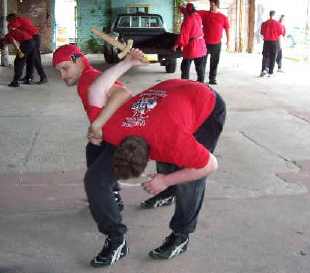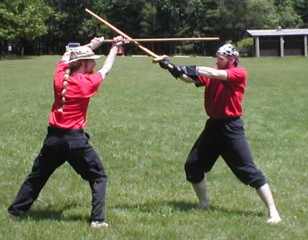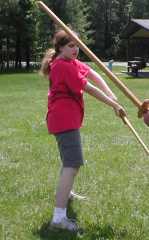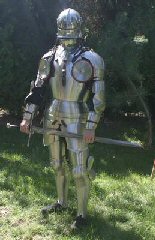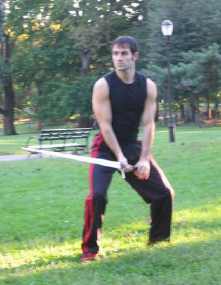Our Year in Review Report - 2004
By John Clements
ARMA Director
This is the fifth of our annual review columns. It is astounding that yet another year has passed. I write this statement every year it seems. But every year it’s true. And every year our knowledge of Renaissance martial arts grows in breadth and depth. As with each previous year we witnessed continued growth in historical fencing studies, a strengthening of scholarship, improvement in understanding, sharpening of skills, and even greater camaraderie among us. Here now are some highlights of the past year:
 In
2004 ARMA broke the 400 member barrier with one 60 day period resulting
in over 30 new applicants—one almost every two days. Overall,
our membership “churn rate” as been a healthy 6 to 1. We added new
Study Groups in Las Vegas, Ohio, Wisconsin, New York, as well as
our first ever in Hong Kong and two more in Sweden. We also added
2 new Senior Free-Scholars. In February we witnessed the successful
Senior Free-Scholar Prize Playing of Stewart Feil at BYU in Provo.
During the summer a successful Senior Free-Scholar Prize Playing
for long-time member Gene Tausk was held outside Houston and for
the first time in a custom champ clos fighting pen. http://www.thearma.org/images/Athens_Buda_04/asg.JPG
In
2004 ARMA broke the 400 member barrier with one 60 day period resulting
in over 30 new applicants—one almost every two days. Overall,
our membership “churn rate” as been a healthy 6 to 1. We added new
Study Groups in Las Vegas, Ohio, Wisconsin, New York, as well as
our first ever in Hong Kong and two more in Sweden. We also added
2 new Senior Free-Scholars. In February we witnessed the successful
Senior Free-Scholar Prize Playing of Stewart Feil at BYU in Provo.
During the summer a successful Senior Free-Scholar Prize Playing
for long-time member Gene Tausk was held outside Houston and for
the first time in a custom champ clos fighting pen. http://www.thearma.org/images/Athens_Buda_04/asg.JPG
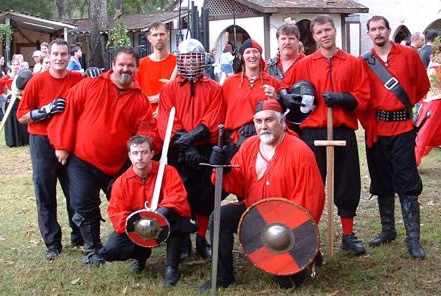 It is continually heartening to witness the numbers of people around the world committing to our campaign for excellence in the discipline of historical fencing studies. Our ratio of new and returning members this summer and fall has been astounding. This does not even reflect the many academic contributors behind the scenes doing translation and research for us because they respect our commitment to integrity and our distinct lack of pretense. Additionally, our reputation among the Asian martial arts community continues to gain respect through demonstration and scholarship. Across the board there is a discernable understanding at work that Renaissance fencing skills are not a chivalric fantasy sport, duelling game, or re-creational role-playing amusement, but a modern combative discipline.
It is continually heartening to witness the numbers of people around the world committing to our campaign for excellence in the discipline of historical fencing studies. Our ratio of new and returning members this summer and fall has been astounding. This does not even reflect the many academic contributors behind the scenes doing translation and research for us because they respect our commitment to integrity and our distinct lack of pretense. Additionally, our reputation among the Asian martial arts community continues to gain respect through demonstration and scholarship. Across the board there is a discernable understanding at work that Renaissance fencing skills are not a chivalric fantasy sport, duelling game, or re-creational role-playing amusement, but a modern combative discipline.
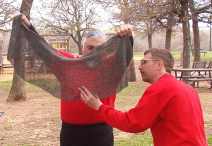 A
significant addition to our structure was the establishment of a
new Senior Researcher title
created to honor major scholarship contributions by our members.
In this way we recognize the invaluable accomplishments in Renaissance
Martial Arts outside of the realm of personal physical skills or
technical application. Our first honorees were Bart Walczak, David
Lindholm, and George Turner.
A
significant addition to our structure was the establishment of a
new Senior Researcher title
created to honor major scholarship contributions by our members.
In this way we recognize the invaluable accomplishments in Renaissance
Martial Arts outside of the realm of personal physical skills or
technical application. Our first honorees were Bart Walczak, David
Lindholm, and George Turner.
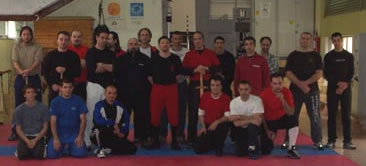 ARMA continued to acquire new
works and research materials and continued further to make inroads
into our understanding of the historical source literature, particularly
with the German longsword styles and the teachings of Liechtenauer
and Meyer. Our curriculum for longsword in particular was refined
and amended to a greater degree than ever and we continued discovering
historical validation for our drills and exercises.
ARMA continued to acquire new
works and research materials and continued further to make inroads
into our understanding of the historical source literature, particularly
with the German longsword styles and the teachings of Liechtenauer
and Meyer. Our curriculum for longsword in particular was refined
and amended to a greater degree than ever and we continued discovering
historical validation for our drills and exercises.
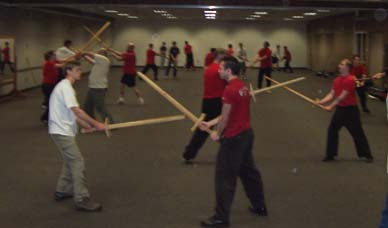 The
year of 2004 was our largest for new articles, essays and editorials.
We continued to push the envelope with a major piece on the importance
of physical conditioning and fitness in historical fencing, an important
article on the actual weight of Medieval swords, the most in depth
research piece yet produced on the history of the pell, and an important
research article on edge damage. A major article of Questions and
Answers about the Rapier was produced this year that ended up being
the largest and most detailed stand-alone article ever written on
the weapon or for the Web. The piece also presented material and
original research never before compiled or pointed out regarding
the nature of the weapon. We received a tremendous amount of positive
response for offering this informative article.
The
year of 2004 was our largest for new articles, essays and editorials.
We continued to push the envelope with a major piece on the importance
of physical conditioning and fitness in historical fencing, an important
article on the actual weight of Medieval swords, the most in depth
research piece yet produced on the history of the pell, and an important
research article on edge damage. A major article of Questions and
Answers about the Rapier was produced this year that ended up being
the largest and most detailed stand-alone article ever written on
the weapon or for the Web. The piece also presented material and
original research never before compiled or pointed out regarding
the nature of the weapon. We received a tremendous amount of positive
response for offering this informative article.
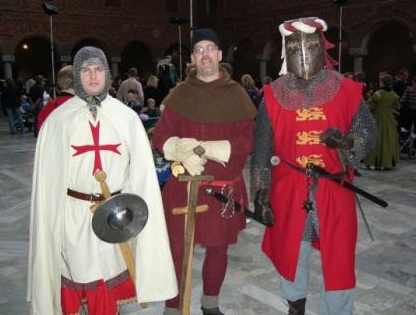 Another major
article was produced covering the weight of two-handed great swords,
which ended up as the most detailed and informative yet written
on this often misrepresented topic. ARMA Stockholm prepared a useful
and insightful analysis of unarmed techniques, ARMA South Florida
continued building on its excellent Joachim Meyer resource, VAB
put together an excellent introduction to armored combat, Jeffrey
Hull presented his own research into Martin Siber, and a combination
of members put together an important new article on the Mastercuts.
The members’ area had several major additions including a lengthy
Liechtenauer study guide, translations of 15th century
dagger manuals, several new training articles, and new videos. We
rounded out the year with one of the most important pieces we have
yet featured, that on Core Assumptions.
Another major
article was produced covering the weight of two-handed great swords,
which ended up as the most detailed and informative yet written
on this often misrepresented topic. ARMA Stockholm prepared a useful
and insightful analysis of unarmed techniques, ARMA South Florida
continued building on its excellent Joachim Meyer resource, VAB
put together an excellent introduction to armored combat, Jeffrey
Hull presented his own research into Martin Siber, and a combination
of members put together an important new article on the Mastercuts.
The members’ area had several major additions including a lengthy
Liechtenauer study guide, translations of 15th century
dagger manuals, several new training articles, and new videos. We
rounded out the year with one of the most important pieces we have
yet featured, that on Core Assumptions.
Our popular and
sometimes controversial article speculating on a hypothetical encounter
between a knight and a samurai was reprinted in the long running
FRPG periodical, Dragon magazine,
while elements of ARMA’s study of historical European longsword
fencing were presented in a well-received article on “fighting with
light sabers” featured on the very popular Star Wars Fan
Network website.
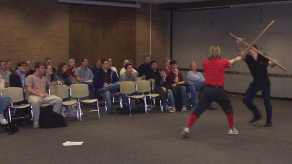
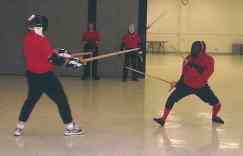
In 2004 ARMA held major events across the USA and Europe, including a NTP 1.3 at Provo, Utah in January, a February workshop in Melbourne, Florida, and a special test-cutting day outside of Houston, Texas. In February, ARMA held “Southern Knights,” our first regional event, in America’s “duelling city,” New Orleans. Attended by more than 30 members from around the Gulf States it featured classes from 7 instructors on 6 different fighting weapons and styles. The success of this event spurred us to arrange other annual regional events in lieu of larger bi-annual international ones.
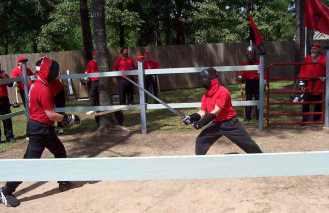 In
2004 we held our first ever seminars in Athens, Greece and Budapest,
Hungary. ARMA-Poland Study Group leader Bart Walczak also once again
proudly represented us at the annual HEMAC event in Dijon, France.
In May, Bart Walczak also instructed at a HEMAC event in Vienna
and gave a seminar on the Codex Wallerstein
in Sweden for our Study Groups there. Senior Free-Scholar and acting
assistant Director, Jacob Norwood, gave his first NTP 1.0 seminar
in Columbus, Ohio, while in July Senior Free-Scholar Stewart Feil
conducted his own first NTP 1.0 seminar in Ogden followed by a second
a NTP 1.0 in Las Vegas. Jake also gave a very impressive 2-day Joachim
Meyer Workshop in the Knoxville, TN, featuring his cutting edge
interpretations of this important work. Jake additionally represented
ARMA at a Canadian conference on athletics in the Renaissance where
he presented a well-received paper on historical European martial
arts and conducted a display of longsword. Members from around Florida
held their own regional training day in Orlando, while the Virginia
Beach Study Group held an all-day training and sparring get-together
with Senior Free-Scholar Tim Sheetz for their VA/DC region.
In
2004 we held our first ever seminars in Athens, Greece and Budapest,
Hungary. ARMA-Poland Study Group leader Bart Walczak also once again
proudly represented us at the annual HEMAC event in Dijon, France.
In May, Bart Walczak also instructed at a HEMAC event in Vienna
and gave a seminar on the Codex Wallerstein
in Sweden for our Study Groups there. Senior Free-Scholar and acting
assistant Director, Jacob Norwood, gave his first NTP 1.0 seminar
in Columbus, Ohio, while in July Senior Free-Scholar Stewart Feil
conducted his own first NTP 1.0 seminar in Ogden followed by a second
a NTP 1.0 in Las Vegas. Jake also gave a very impressive 2-day Joachim
Meyer Workshop in the Knoxville, TN, featuring his cutting edge
interpretations of this important work. Jake additionally represented
ARMA at a Canadian conference on athletics in the Renaissance where
he presented a well-received paper on historical European martial
arts and conducted a display of longsword. Members from around Florida
held their own regional training day in Orlando, while the Virginia
Beach Study Group held an all-day training and sparring get-together
with Senior Free-Scholar Tim Sheetz for their VA/DC region.
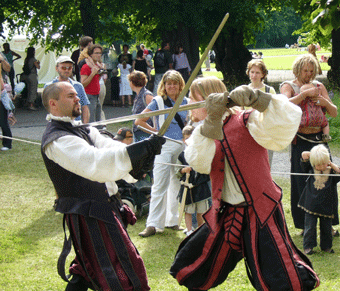 Members
also held smaller training days in Long Beach, Mississippi as well
as in the Atlanta, Georgia area under Director John C.
Houston members gave fighting demos and historical presentations
to area high-schools and in June to the Cub Scouts Day Camp in Rosenberg,
Texas, while in September the DFW group delivered a paper on "The
Myth of Strength and Medieval Knightly Combat" to the Texas
medievalist association annual conference in Irving. On the opening
weekend of the Texas Renaissance Festival in October members from
Houston, DFW, and Texas A&M over two days staged the first ever
series of historical fencing training and free-play demos at this,
the nation's largest such festival of its kind. The BYU Study Group in Provo also held their annual “pumpkin
slaying” test-cutting the day before Halloween, conducted demonstrations
for Student Association week and for local elementary schools and
a Renaissance festival in May. Our Swedish members also performed
exhibitions of Medieval sword combat and rapier fencing at several
events and locations.
Members
also held smaller training days in Long Beach, Mississippi as well
as in the Atlanta, Georgia area under Director John C.
Houston members gave fighting demos and historical presentations
to area high-schools and in June to the Cub Scouts Day Camp in Rosenberg,
Texas, while in September the DFW group delivered a paper on "The
Myth of Strength and Medieval Knightly Combat" to the Texas
medievalist association annual conference in Irving. On the opening
weekend of the Texas Renaissance Festival in October members from
Houston, DFW, and Texas A&M over two days staged the first ever
series of historical fencing training and free-play demos at this,
the nation's largest such festival of its kind. The BYU Study Group in Provo also held their annual “pumpkin
slaying” test-cutting the day before Halloween, conducted demonstrations
for Student Association week and for local elementary schools and
a Renaissance festival in May. Our Swedish members also performed
exhibitions of Medieval sword combat and rapier fencing at several
events and locations.
I
myself suffered a physical setback in 2004 that interrupted my teaching
and training schedule. I experienced a torn pectoral muscle and severed tendon as
a result of an inexperienced, overzealous, and unsafe youth who
attempted an inappropriate unarmed throw during casual sparring.
The incident underscores the inherent dangers of grappling techniques
as well as the dangers of inexperienced beginners, and (especially) the dangers of
working with anyone who is unable to speak the same language so
that they understand and agree to fundamental aspects of safe practice. As a
result, I was sidelined with 3 months of impaired physical activity
and, following successful surgery, 5 months physical recuperation
that is presently ongoing. Combined with relocating my family to
a new state, my own opportunities for instruction and research were
limited in 2004 but were made up for by dedicated commitment of
several energetic and knowledgeable senior members.
This is an exciting
time of exploration and rediscovery for the emerging field of historical
fencing studies. This past year, to help clarify and distinguish
what ARMA is really about and what exactly we do, we posted a new
description that our members agreed was the most accurate and well-stated
outline we have yet offered. While it actually said nothing new,
it said it in a manner that is unmistakeable. The section is worth
repeating here:
ARMA is a collective effort of hundreds of internationally networked practitioners, researchers, and specialists engaged in physical and academic study of European martial arts literature and weaponry covering more than a 600-year period. Our members conduct serious in-depth research and on-going scholarship of a range of historical fighting texts and documents. A large part of the ARMA's energy is directed at interpretation and integration of translated source material into practical hands-on curriculum. We continually refine a curriculum of martial training and practice methods through our transcriptions, translations, interpretations, and physical application of these sources. Through our historical fencing studies we seek to understand the overall nature of personal combat and fighting arts from the period as well as the true function and use of historical arms and armor. Through exercise and credible non-lethal demonstration we are attempting to revive these lost arts and re-develop real self-defense skills by understanding their combat effective application. This also involves developing a corresponding comprehensive modern training curriculum. In this, we endeavor to follow a broad, pragmatic interpretation of the historical sources focused on earnest physical application of their teachings by maintaining an appreciation for the physicality and seriousness of the craft, pursuing it neither in an overly technical nor exclusively academic manner and without concern for sporting contests, entertainment display, or role-playing recreation.
By investigating both the commonalities and the distinctions of integral elements within the historical source literature, our study attempts to go beyond any theoretical or academic understanding toward a practical one of how these principles and concepts were applied by fighting men in actual combat. This never-ending process combines scholarly discipline with rigorous neuromuscular development. Scholarly research in these handwritten manuscripts and published books proceeds by artistic, codicological, linguistic, and paleographical analysis, followed by cross-comparison with one another’s thematic and contextual structure, aim, and origin. Hoplological or physical exploration of these works consists of identifying the principles, concepts, and techniques of their teachings then practicing them as combative skills. For this our organization offers an immense collection of materials and educational resources to promote the subject by raising its credibility and legitimacy. We arrange and host presentations, seminars, classes, and symposiums, offer consulting to public and private institutes and individuals, as well as perform roles of public advocacy and consumer protection for weapon owners. In the process, ARMA confronts the many long-accepted myths, misconceptions, and nonsense surrounding the subject while simultaneously challenging modern students to further advance the emerging field of Renaissance martial arts study.
ARMA has long stressed the import of both prowess and scholarship combined, while acknowledging that each alone has an important role on its own. For those in our organization who are still developing either, we stress the virtue of maintaining good character. A change to our organization in 2004 that was received with enthusiasm was the addition of a Code of Conduct. For ARMA this means Respect for History and Heritage. The more deeply we immerse ourselves in the teachings of the historical source literature, the clearer it becomes that there is often a strong ethical component within the fighting guides. They were not just concerned about self-defense isolated from human concern but often address when and where and under what conditions it was appropriate to use violent force. More subtle and practical than familiar chivalric notions of the period, this philosophical element reflects ideals of Latin Christendom as well as both Classical virtues and the new Humanism of the age. Since the 12th century knights in particular had already recognized the virtues of Sapientia, Fortitudo, Prudentia—or reason, courage, and caution. Thus, ARMA took as our Credo of Renaissance Martial Arts Studies: Sincerity of Effort, Integrity of Scholarship, Appreciation of Martial Spirit, and Cultivation of Self-Discipline. Applied to the pursuit of our craft, to our scholarship, our art, our personal training and advancement, these four ideas cannot help but also come to impact upon how we conduct ourselves in our daily lives—and as a result, upon our interaction with our family, friends, community or church. We come to understand the reality of Medieval and Renaissance martial history not as mere weekend chivalric role-play or escapist cavalier theatrics, but as something considered and weighed. We come to understand honor as personal principal, not an abstract occasionally discarded when inconvenient in business dealings, civic responsibilities, or private affairs. Who would have thought…Renaissance martial arts builds character. What a concept.
That was 2004 for ARMA.
